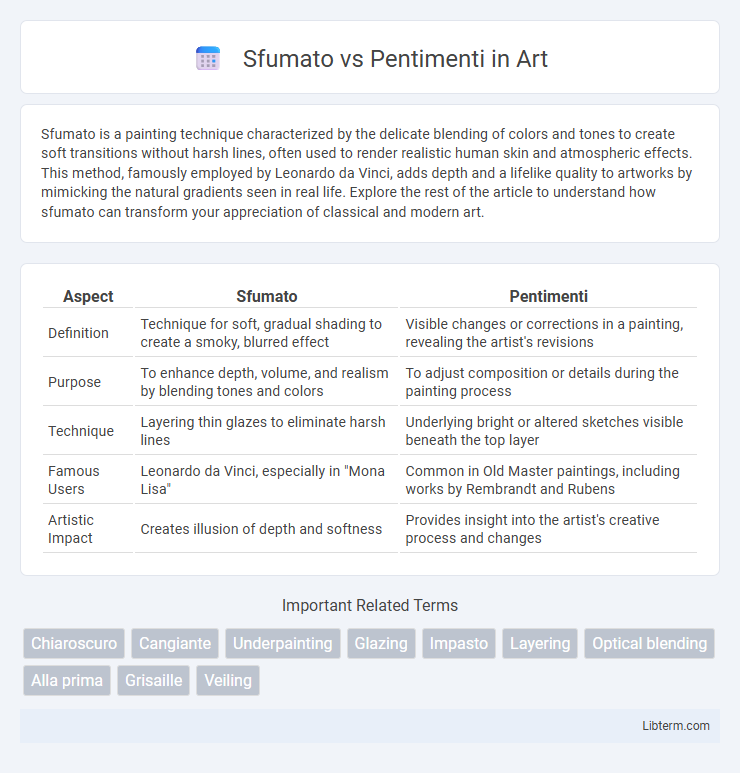Sfumato is a painting technique characterized by the delicate blending of colors and tones to create soft transitions without harsh lines, often used to render realistic human skin and atmospheric effects. This method, famously employed by Leonardo da Vinci, adds depth and a lifelike quality to artworks by mimicking the natural gradients seen in real life. Explore the rest of the article to understand how sfumato can transform your appreciation of classical and modern art.
Table of Comparison
| Aspect | Sfumato | Pentimenti |
|---|---|---|
| Definition | Technique for soft, gradual shading to create a smoky, blurred effect | Visible changes or corrections in a painting, revealing the artist's revisions |
| Purpose | To enhance depth, volume, and realism by blending tones and colors | To adjust composition or details during the painting process |
| Technique | Layering thin glazes to eliminate harsh lines | Underlying bright or altered sketches visible beneath the top layer |
| Famous Users | Leonardo da Vinci, especially in "Mona Lisa" | Common in Old Master paintings, including works by Rembrandt and Rubens |
| Artistic Impact | Creates illusion of depth and softness | Provides insight into the artist's creative process and changes |
Introduction to Sfumato and Pentimenti
Sfumato is a painting technique characterized by soft, gradual transitions between colors and tones, creating a smoky, blurred effect without harsh outlines. Pentimenti refers to the visible traces of an artist's earlier alterations in a painting, revealing changes made during the creative process. Both concepts highlight different aspects of artistic expression--Sfumato emphasizing subtle visual blending and Pentimenti revealing the evolution of the artwork beneath the surface.
Origins and Historical Context
Sfumato, originating in the Italian Renaissance, was pioneered by Leonardo da Vinci to create soft transitions between colors and tones, enhancing realism through subtle gradations without harsh outlines. Pentimenti, deriving from the Italian word for "repentance," appear as traces of early compositions beneath paintings, revealing artists' changes and creative decisions especially during the Renaissance and Baroque periods. Both techniques highlight historical artistic processes but serve distinct purposes: sfumato for visual effect and pentimenti as evidence of evolving creative intent.
Key Characteristics of Sfumato
Sfumato is characterized by its soft, gradual transitions between colors and tones, creating a smoky, blurred effect that enhances depth and realism without harsh outlines. This technique, famously used by Leonardo da Vinci, relies on delicate layering of glazes to achieve subtle gradations and atmospheric perspective. Unlike pentimenti, which reveal an artist's changes or corrections beneath the surface, sfumato's key feature lies in its smooth, seamless blending that evokes a lifelike, three-dimensional quality.
Defining Pentimenti in Art
Pentimenti in art refer to visible alterations or corrections made by artists during the painting process, revealing earlier compositional elements beneath the final surface. Unlike sfumato, which is a technique of blending colors and tones for smooth transitions, pentimenti provide insight into the artist's evolving vision and decision-making. These underlying changes offer art historians crucial evidence of creative adjustments and developmental stages in masterpieces.
Techniques Behind Sfumato
Sfumato is a painting technique characterized by soft, gradual transitions between colors and tones, creating a smoky, blurred effect that enhances depth and realism, famously used by Leonardo da Vinci in works like the Mona Lisa. It involves careful layering of translucent glazes, allowing colors to merge seamlessly without harsh outlines, which requires meticulous control of brushwork and pigment application. Unlike pentimenti, which reveal changes or corrections beneath a painting's surface, sfumato focuses on subtle blending to achieve atmospheric effects and lifelike textures.
Identifying Pentimenti in Paintings
Pentimenti in paintings reveal the artist's alterations made during the creative process, often visible as underlying sketches or changes in composition beneath the surface layer. Identifying pentimenti involves using techniques like infrared reflectography or X-radiography, which uncover these hidden corrections and modifications. Unlike sfumato, which is a deliberate blending technique for soft transitions of tone and color, pentimenti expose the evolving decisions and revisions of the artist.
Famous Artists Using Sfumato
Famous artists employing sfumato include Leonardo da Vinci, whose *Mona Lisa* exemplifies the technique's delicate blending of tones to create soft transitions without harsh lines. Raphael also integrated sfumato to enhance realism in his portraits, while Correggio used it to achieve atmospheric effects in religious scenes. These masters utilized sfumato to evoke depth and subtlety, distinguishing their work from clear outlines and demonstrating technical control over light and shadow.
Notable Examples of Pentimenti
Pentimenti refer to visible changes or corrections made by artists during the painting process, revealing altered compositions beneath the surface. Notable examples include Leonardo da Vinci's "Lady with an Ermine," where pentimenti adjustments highlight his evolving vision, and Rembrandt's works, such as "The Night Watch," displaying compositional shifts indicative of his creative process. These underlying modifications contrast with the soft blending technique of sfumato, emphasizing the artist's decision-making rather than atmospheric transitions.
Artistic Impact: Sfumato vs Pentimenti
Sfumato enhances artistic impact by creating soft transitions between colors and tones, producing a lifelike, atmospheric depth and subtlety in paintings. Pentimenti reveal the artist's creative process through visible corrections or alterations, adding a dynamic, historical layer that highlights evolving artistic decisions. While sfumato achieves visual harmony and emotional nuance, pentimenti emphasize the artwork's development and authenticity over time.
Legacy in Modern Art Practices
Sfumato and pentimenti both significantly influence modern art practices, with sfumato's subtle gradation of tones inspiring contemporary approaches to realism and atmospheric depth. Pentimenti, revealing the artist's process through visible corrections, encourages transparency and experimentation in modern mixed media and digital art. Together, they shape legacy techniques that balance technical mastery and creative evolution in today's art scene.
Sfumato Infographic

 libterm.com
libterm.com